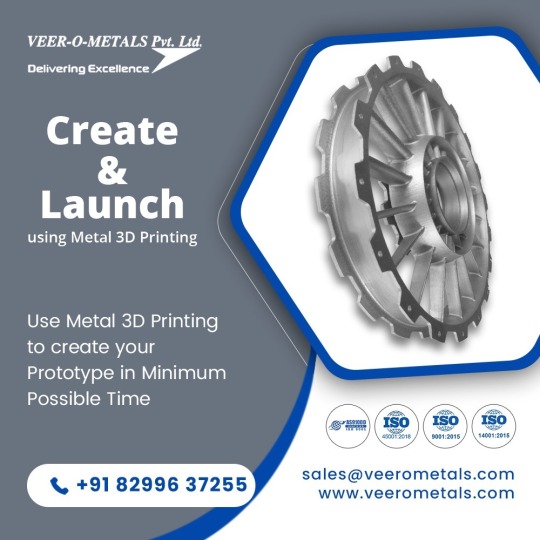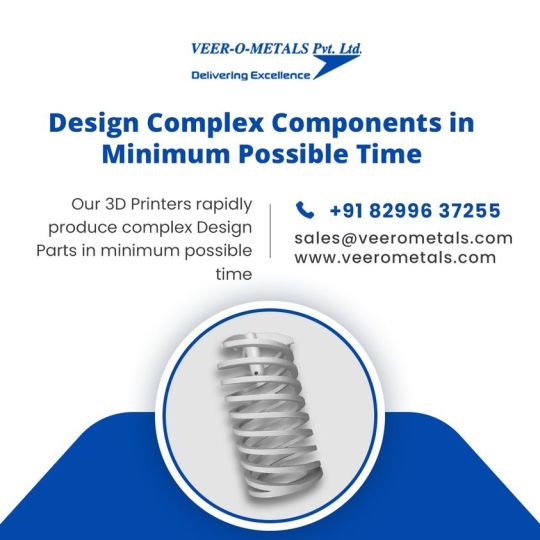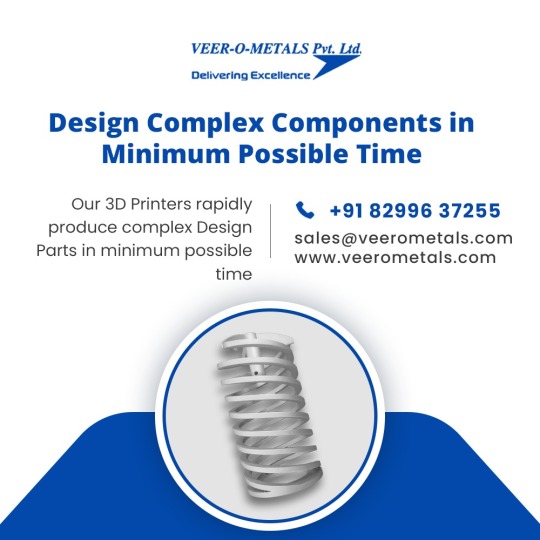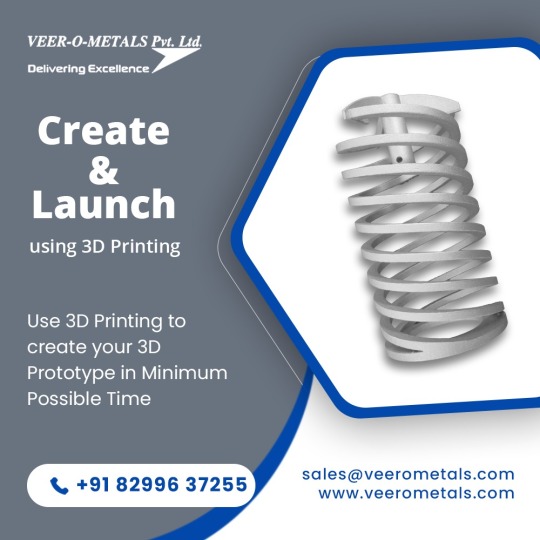Text

#metaladditivemanufecturing#metal3dprintingtechnology#meta3dprinting#metal3dprintingmaterials#Additive Manufacturing Solutions And Services | Metal 3D Printing in Bangalore Get a quote Today. For further information#kindly contact 9739991967 | 80-23712195 visit us : https://veerometals.com/ Mail us : [email protected]#veerometals#additivemanufacturing#metal3dprinting#3dprinting#sales#bangalore
0 notes
Text

Metal Enclosures
Use Metal 3D Printing to Create Your Prototype in Minimum Possible Time. With Veer-O-Metals, you can take your business to the next level.
Get a quote Today.
For further information,
kindly contact 9739991967 | 80-23712195
visit us : https://veerometals.com/
Mail us : [email protected]
#veerometals #additivemanufacturing #metal3dprinting #3dprinting #3dprinting #aeroindustry #aerospace #healthcare #construction #industry #supplychain #help #quality #sales #business #metaladditivemanufecturing #metal3dprintingtechnology #meta3dprinting #metal3dprintingmaterials
0 notes
Text
Metal Enclosures
Use Metal 3D Printing to Create Your Prototype in Minimum Possible Time. With Veer-O-Metals, you can take your business to the next level.
Get a quote Today.
For further information,
kindly contact 9739991967 | 80-23712195
visit us : https://veerometals.com/
Mail us : [email protected]
#veerometals #additivemanufacturing #metal3dprinting #3dprinting #3dprinting #aeroindustry #aerospace #healthcare #construction #industry #supplychain #help #quality #sales #business #metaladditivemanufecturing #metal3dprintingtechnology #meta3dprinting #metal3dprintingmaterials
0 notes
Text
Understanding of 3D Metals Printing
Additive manufacturing, or 3D metal printing, is a process that uses metal to build three-dimensional things layer by layer. The process depends on sending a digital data file to a machine that manufactures the component after receiving it. Complex items are produced using metal additive manufacturing without the limitations of conventional manufacturing techniques.
Metal components could not have been produced with 3D printing a few years ago. They may now be produced to strict standards utilizing a variety of metal powders. The fabrication of components for the most demanding purposes now makes use of it.
Metal part manufacture is a wasteful process in traditional processes. When making metal components for aircraft, up to 90% of the material is removed. Less energy is used and there is very little waste when using the 3D method. Up to 60% less weight can be added to finished 3D printed objects compared to their machined counterparts.
In the next few years, Veer-O-Metals, a significant player and one of the leading sheet metal stamping companies in India in the direct-metal printing market, expects that its metals business to reach a massive growth in the market. They have a strong technical team to handle all nature of work in the metal manufacturing segments.
For metal 3D printing, a number of metal materials are available. Stainless steel, aluminum, nickel, cobalt-chrome, and titanium alloys are the most often utilized materials. Tool steels, nickel-based alloys, precious metal alloys, and copper alloys are further materials. Tensile strength, hardness, and elongation characteristics are crucial when choosing a material. The proper material for a project can be easily taken into account in a product's specification due to the broad variety of materials available.
No filaments are used in 3D metal printing. The foundation is actually a very fine steel powder. Since 3D printers will be producing extremely thin printing layers, any form of powder cannot be used. To hold an even surface, the powder needs to be correctly formed. A roller is used to spread a very thin layer of steel powder. The design-related portions of the layer are then covered with tiny drips of glue by a printer head. Next, the layer is dried with the use of strong overhead heaters. The printer head will systematically adhere the right areas of each layer together while the 3D printer continues to spread out one layer of powder after another.
The most active sector of the economy has been the automotive sector, which has made investments in additive manufacturing for both mass-produced and prototype products. Automakers are refining their prototypes and beginning to mass produce more of their components and specialized equipment.
The metal 3D process has a number of benefits. Complex, customized pieces that are impossible to fabricate using traditional manufacturing techniques can be created using metal printing procedures. The application of metal 3D Machined components can be maximized while minimizing their weight and the overall number of components in a fabrication.
Superior physical qualities can be found in metal 3D printed items. Materials that are challenging to process, such metal superalloys, are among the range of materials that are available. If a design needs to be modified, the process is simple and simply necessitates the pressing of a few buttons, as opposed to an expensive and time-consuming re-design. Because the design is created as a single continuous piece rather than using several welds, the finished goods are sturdy and strong.
#veerometals#additivemanufacturing#metal3dprinting#3dprinting#aeroindustry#aerospace#healthcare#construction#industry#supplychain#help#quality#sales#business#metaladditivemanufecturing#metal3dprintingtechnology#meta3dprinting#metal3dprintingmaterials
0 notes
Text
Sheet Metal Stamping

Veer O Metals was established in 1965. We are engaged in the manufacture of Stamped Parts, Precision Sheet Metal Fabrication Parts, Machined Components and Mechanical Assemblies.
Use Metal 3D Printing to Create Your Prototype in Minimum Possible Time. With Veer-O-Metals, you can take your business to the next level.
Get a quote Today.
For further information,
kindly contact 9739991967 | 80-23712195
visit us : https://veerometals.com/
Mail us : [email protected]
#veerometals #additivemanufacturing #metal3dprinting #3dprinting #3dprinting #aeroindustry #aerospace #healthcare #construction #industry #supplychain #help #quality #sales #business #metaladditivemanufecturing #metal3dprintingtechnology #meta3dprinting #metal3dprintingmaterials
0 notes
Text

#veerometals#additivemanufacturing#metal3dprinting#3dprinting#aeroindustry#aerospace#healthcare#construction#industry#supplychain#help#quality#sales#business#metaladditivemanufecturing#metal3dprintingtechnology#meta3dprinting#metal3dprintingmaterials
0 notes
Text
The Future Of 3-D Metal Printing
The power of Metal 3D printing is unstoppable. Prior to recently, 3-D printers could only be used for fast prototyping due to their slow printing speed and output limitations. However, 3-D printers will be at the centre of full-scale manufacturing capabilities in a number of industries, including aerospace, automotive, health care, and fashion, in the upcoming years. The way we currently manufacture things will never be the same.
This transformation did not suddenly occur on the scene. We are on the verge of an industrial revolution in 3-D printing thanks to decades of invention. But as a result of recent developments in speed, printing technology, and material capacities, the entire industry will advance.
Direct-Metal Printing Advances
Numerous new technologies are currently in use, and direct-metal printing is becoming quicker and more capable. There are more and more metal alloys that can be 3-D printed, and they offer excellent performance qualities. High-performance light weighting and complexity are achievable, although they are not using conventional design and production methods. Consider the potential outcomes of these modifications: Soon, complex and intricate items necessary for the aerospace, automated, and mechatronic sectors will be produced for a fraction of the price. Soon, you'll be able to buy a shift knob or fuel-door hinge pin that was swiftly and cheaply manufactured if your automobile requires a repair. The same technique will be used by aerospace engineers to create jigs and fixtures for spacecrafts.
In the next few years, GE, a significant player in the direct-metal printing market, expects that its metal business alone would generate more than $1 billion in sales annually. Additionally, many hundred million dollars have been invested in early-stage businesses like Desktop Metal and Mark forged in order to provide low-cost direct-metal printing solutions.
Therefore, small, upstart businesses will challenge traditional CNC machining and neighbourhood machine-shop industries. On the other hand, you can witness GE and numerous other 3-D firms' high-complexity, precision aero frame production solutions.
Selective laser sintering innovations
A number of nylon materials can be used to create items using selective laser sintering (SLS). It has been used for many years in a few different sectors.
Consider the fighter plane F-18: Air ducts, electronics covers, and numerous other components have been flying on every F-18 in use today for a number of decades. Thus, it is not breaking news.
However, recently, businesses like HP have entered the market with technology that quickens the production of specific laser-sintered parts. Hundreds of times faster than conventional SLS machines, once more. Instead of relegating selective laser sintering to highly specialised applications like the F-18, it will help make the technology more widely used.
With the introduction of these quicker equipment, businesses are now substantially more able to improve manufacturing size and speed. It is now used for commonplace military, defence, and aerospace applications. It is prepared to become popular.
What Future Changes These Innovations Will Bring
The realisation of Industry 4.0 a genuinely cognitive, adaptive, and largely self-optimizing factory—occurs when you combine all these developments with endless computing capacity in the cloud, IoT connection, big data, and next-generation robotics. And additive manufacturing will play a significant role in catalysing and fuelling this enormous development.
3-D printing has been discussed or used for many years in several industries. However, design and prototyping have been the main use cases. Aerospace and automotive are two industries that are quite familiar with this technology, and they are starting to release these capabilities so that others may make workable tools, fixtures, jigs, and end-use parts. The use of Metal Additive Manufacturing
for additive manufacturing has only just begun to be explored. Additionally, many businesses will spend money on continuous photopolymer systems.
According to Gartner, the growth rate of photopolymer 3-D printers would likely reach around 75% in the coming years.
More and more 3-D printers are being utilised to produce surgical tools, hip replacements, hip replacement parts, hearing aids, dental fixtures, and other customised medical items in industries like health care. Dental applications are best served by high-speed photopolymer methods, but some implants might benefit from direct-metal and SLS solutions.
The proliferation of 3-D printers in public libraries and schools is perhaps the most significant aspect of another trend that is emerging. In addition to learning how to use 3-D printing equipment and design software, kids also expect to be able to use it. There are many metals stamping companies in India who provides a top class products.
#Metal 3D Printing#stamped parts#sheet metal stamping companies in india#additivemanufacturing#metal3dprinting
0 notes
Text
BENEFITS OF 3D PRINTING TECHNOLOGY
SPEED
Rapid prototyping is one of the main benefits of 3D printing technology. The capacity to design, produce, and test a customised part quickly is known as rapid prototyping. Additionally, if necessary, the design can be changed without impairing how quickly something is made. Before the 3D printing business took off, it would take weeks to produce a prototype. The procedure took an additional few weeks each time a change was made. When shipping schedules are taken into account, the entire product development process might easily take a year. Using 3D printing methods, a company may design a product, produce it internally on a 3D printer, and test it all in a matter of days.
COST
The most economical manufacturing method is 3D printing for small production runs and applications. A lot of expensive machines are needed for traditional prototyping techniques like CNC machining and injection moulding, and their higher labour costs are a result of the need for skilled operators and technicians to operate the machines.
This is in contrast to the 3D printing process, where (depending on the system) just 1 or 2 machines and fewer operators are required to make a part. Because the part is constructed from the ground up rather than being cut out of a solid block as in subtractive manufacturing, there is far less waste material and it typically does not require additional tooling.
SUITABILITY
A significant benefit of 3D printing is that any printer can produce practically anything as long as it fits inside its build volume. With conventional manufacturing techniques, each new part or modification to an existing part design necessitates the production of a new tool, mould, die, or jig.
In 3D printing, the design is input into slicer software, any supports that are required are added, and the print is then completed with little to no changes to the actual hardware or tools. Geometries that are hard for traditional technologies to construct, either as a single part or at all, can be designed and manufactured using 3D printing. Geometries of this type contain pieces inside other parts and hollow voids inside solid objects.
CONCURRENT ADVANTAGE
Product life cycles are shortened by 3D printing's speed and cheaper prices. Businesses have the ability to develop and improve a product, enabling them to provide better products in less time. By enabling a physical demonstration of a new product to customers and investors rather than relying solely on their imaginations, 3D printing lowers the likelihood that information will be lost or misconstrued during communication.
Additionally, it enables risk-free market testing at a minimal cost, collecting input from prospective buyers and investors on a physical product without having to incur significant up-front costs for prototyping.
Product Durability
Traditional production techniques might lead to subpar designs and subpar prototypes. Imagine making a cake, where the various components are joined, mixed, and then baked in the oven. If this were to occur, the cake would have issues like air bubbles or might not bake all the way through. With subtractive or injection processes, the same thing can happen; quality is not always guaranteed.
Due to the nature of 3D printing, it is possible to assemble a component or product piece by piece, which ensures that the design will be improved and the part or product will be of higher quality.
PRODUCT TESTING AND TANGIBLE DESIGN
As was previously said under competitive advantages, holding and feeling a prototype in person is incomparable to viewing a product on a screen. Testing a physical prototype allows for the discovery of any problems, which can then be corrected in the CAD file and a fresh copy printed the following day.
ECO-FRIENDLY
Fewer parts require outsourced for metal stamping manufacturers thanks to 3D printing. As a result, there is a decrease in the amount of shipping that occurs around the world and there is no longer a requirement to run and maintain an energy-intensive manufacturing.
For a single product, 3D printing generates a lot less waste, and the materials are frequently recyclable. The key benefits of 3D printing may be seen in its benefits in terms of speed, flexibility, and cost. The usage of 3D printing is far preferable than conventional industrial processes for short production runs, prototyping, small businesses, and educational purposes.
0 notes
Text

0 notes
Text
Metal Stamping
Veer O Metals was established in 1965. We are engaged in the manufacture of Stamped Parts, Precision Sheet Metal Fabrication Parts, Machined Components and Mechanical Assemblies.
Get A Free Quote! 3D Print Service For Build Your Ideas 100% Accuracy. Quality Assurance.
For further information,
kindly contact 9739991967 | 80-23712195
visit us : https://veerometals.com/
Mail us : [email protected]
#veerometals #additivemanufacturing #metal3dprinting
0 notes
Text

0 notes
Text
Sheet Metal Stamping
Veer O Metals was established in 1965. We are engaged in the manufacture of Stamped Parts, Precision Sheet Metal Fabrication Parts, Machined Components and Mechanical Assemblies.
3D Printing Services - 3D Printing Solution in India - Get quote - 3D prototype for your Business
Get a quote Today. For further information,
kindly contact 9739991967 | 80-23712195
visit us : https://veerometals.com/
Mail us : [email protected]
#veerometals #additivemanufacturing #metal3dprinting
— at Veerometals pvt Ltd
0 notes
Photo

Additive Manufacturing Solutions And Services | Metal 3D Printing in Bangalore.
Get a quote Today. For further information, kindly contact 9739991967 | 80-23712195
Visit us : https://veerometals.com/
Mail us : [email protected]
0 notes
Text
Sheet Metal Stamping
We have established a strong client base at National and International level with our transparent and Global practices, and at the same time retaining robust quality management systems. By developing indigenously designed products of global standards for various sectors, we have added a new dimension to our already existing wide range of product manufacturing and assemblies.
Metal 3D Printing Services Providers in Bengaluru, Karnataka. Get contact details and address of Metal Printing Services
Get a quote Today. For further information, kindly contact 9739991967 | 80-23712195
visit us : https://veerometals.com/
Mail us : [email protected]
#veerometals #additivemanufacturing #metal3dprinting #3dprinting #printing #sales
0 notes


